
December 7th
The movie is done by the John Ford.
 |
There's a narrator to open the program.
 |
 |
A letter from the Secretary of War asking for a film about the events that took place at Pearl Harbor.
 |
A letter from the Secretary of the Navy.
 |
Scenes from before the attack.
 |
“Uncle Sam lay sleeping...”
 |
An alert had been in place for an uprising on the island or acts of sabotage.
 |
Planes at Hickam field had been moved close to each other to prevent against sabotage.
 |
The film then talks about the ships at Pearl Harbor that lay at anchor. Notice the Japanese (probably Issei) in the foreground; this, plus the earlier mention of a the possibility of an “uprising” on the island is, I think, sort of a slap against the faces of the Japanese Americans living in Hawaii.
 |
Field church services are being held since it's a Sunday morning.
 |
A few minutes after seven a radar operator picks up a blip. Notice the rather large censored portion, hiding the radar screen.
 |
The guy phones whoever he's supposed to, but that guy is inexperienced and thinks the flight of planes the first guy saw is some B-17's that are expected from the mainland. The film says that if the guy's warning had been heeded, some things might have changed about the attack.
 |
7:50, and the sound of the Japanese planes approaching is heard.
 |
The Japanese planes move in to the attack. At the same time, the Japanese envoys were giving a message of protest to the state department.
 |
“At 7:55 A.M. hell broke loose."
 |
“A man-made hell, made in Japan.”
The couple looks on as some of the civilian areas catch fire, are bombed or strafed.
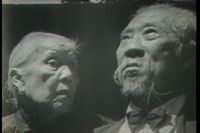 |
The second phase of the attack begins.
The film claims around 50 Japanese planes were shot down. (Actual Japanese losses were about half of that). The film also says that the attackers were “beaten off.”
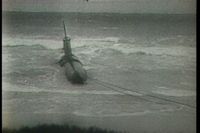 |
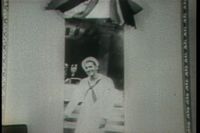 |
The film goes through a few minutes of over-the-top dramatic narration, then has some of the men killed at Pearl Harbor “introduce themselves.”
The map of Japan and the radio tower is representing a speech by Tojo against the United States.
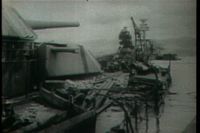 |
As the voice of Tojo (faked voice, that is) announces specific things destroyed, the American narrator says either he was accurate or incorrect.
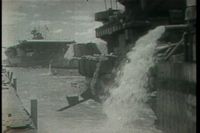 |
A massive recover and repair operation is undertaking, with men working in shifts every hour of the day.
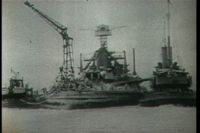 |
The 23-year-old California is refloated and towed to drydock.
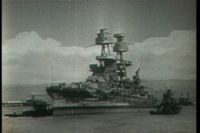 |
The 28-year-old Nevada gets the same type of attention.
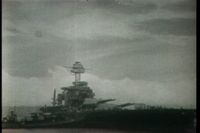 |
The 21-year-old West Virginia, likewise.
The ships are repaired. (This is one of the places the Japanese made a dangerous miscalculation. They apparently thought that just sinking ships was enough, but it was ships at a harbor. If the ships had been sunk at sea, they might not have been recoverable, but in a harbor, some of the ships could be refloated, put into drydock, fixed and updated. Granted, it took time, but the ships were made servicable. The Japanese did not bother to try and destroy the oil tanks or all the repair faciltiies; if they had done that, the ships would not have been ready for a much longer time.)
Even the Oglala, a minelayer, is repaired.
Convoys arrive at the Hawaiian islands with reinforcements and supplies. (Again, here was a mistake of the Japanese; they did not manage to make any type of serious dent in the shipping from the mainland to Hawaii. From what I have read, the Japanese never really made full, effective use of their submarine force.)
The governor of Hawaii declares martial law for the civilian population of the islands.
The film shows various things being done on the island for protection. This trench was supposed to be a shelter area for schoolchildren.
The film finally addresses the persons of Japanese ancestry living on the islands, and says that they wiped out every vestige of the Japanese word from signs, storefronts, etc.
The Japanese language schools were closed.
The Shinto temples were “empty and boarded up.”
Main Index
Japan main page
Japanese-American Internment Camps index page
Japan and World War II index page
|